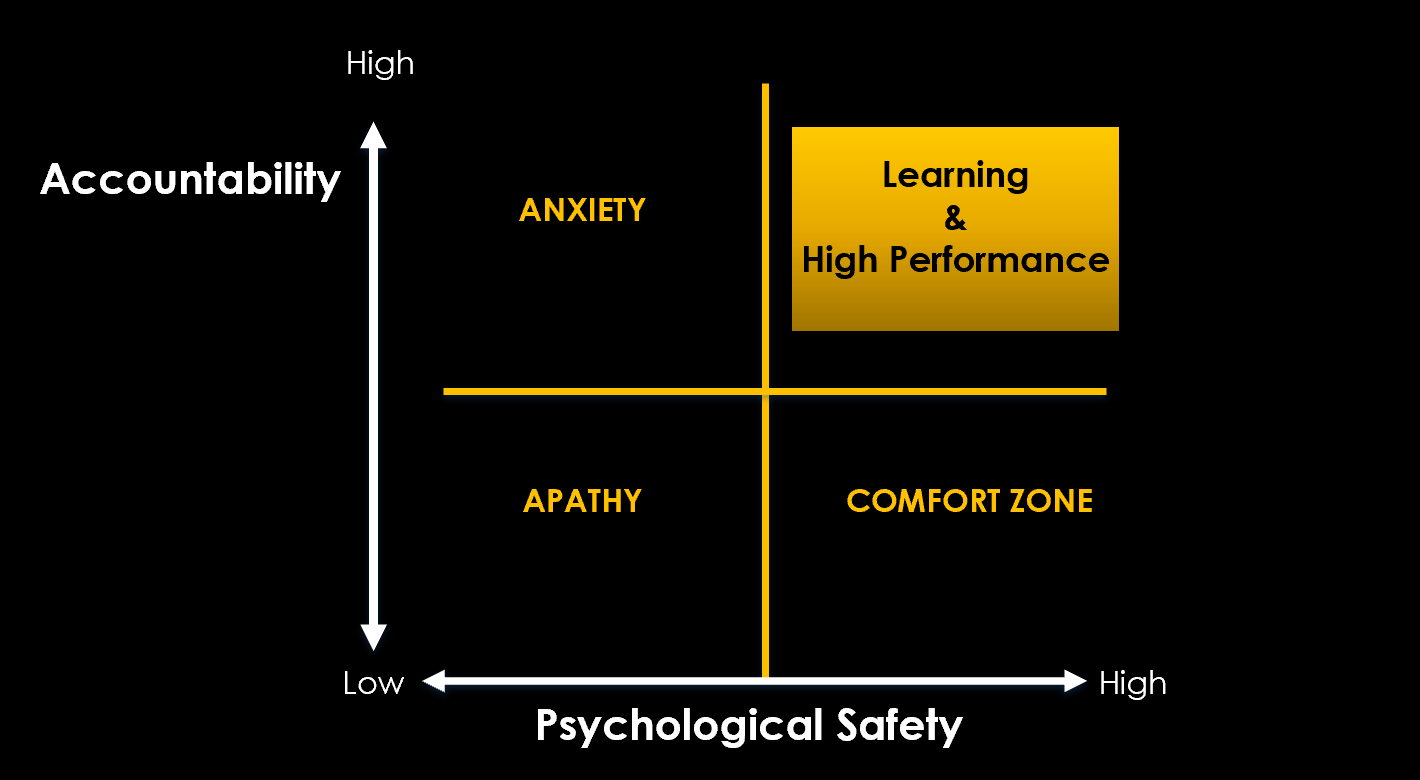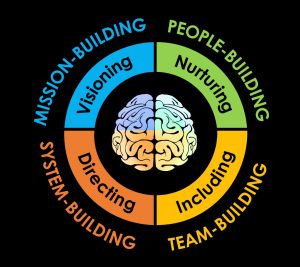What Actually Creates High-Performing Teams?
(Hint: It’s not just psychological safety)

Thanks to studies by Amy Edmondson, Google and others, it is now well understood that psychological safety is an important factor in team performance. Defined by Edmondson as, “A shared belief held by members of a team that the team is safe for interpersonal risk taking” (Edmondson, 1999, p. 354) psychological safety is crucially important to high performance in teams. However, it does not, on its own, create a high-performing team.
In her more recent work, The Fearless Organisation, Edmondson explains why, naming a second essential ingredient for high performance and using the following chart to carry the narrative (Edmondson, 2018, p. 23):

Without accountability for performance, high levels of psychological safety simply puts a team into a non-performing comfort zone. Conversely, where there is low or no psychological safety, team members are anxious about their own welfare and performance suffers because they are giving too much attention to watching their own backs.
Google’s Aristotle project resonated with Edmondson’s findings on the importance of psychological safety, but then went on to cite four other factors and not calling out accountability specifically amongst those:
- 1. Psychological Safety: A shared belief held by members of a team that the team is safe for interpersonal risk taking.
- 2. Dependability: Team members reliably complete quality work on time.
- 3. Structure and Clarity: Clear roles, plans, and goals.
- 4. Meaning: Work is personally important to team members.
- 5. Impact: Team members believe their work matters and creates change.
This begs the question whether high performance in teams is best explained by:
- High performance = psychological safety + accountability, or
- High performance = psychological safety + dependability + structure and clarity + meaning + impact?
What followed was an analysis of five meta-analytical studies, exploring high performance in teams, which found that there are some very compelling alternatives to either of these. Here are the factors that have the highest correlation coefficients related to high performance, according to our analysis:

Psychological safety, depending on which meta-analysis you use, comes in at either 3rd or 4th and “team cohesion” is the most strongly correlated factor, followed by “shared leadership”, “team confidence”, “psychological safety” and “trust”. So High performance = team cohesion + shared leadership + team confidence + psychological safety + trust.
So What?
High performance in teams is more complex than simply creating psychological safety, or even psychological safety + accountability. It requires several conditions that can fluctuate in relative importance, depending on variables like the nature of the team and the degree to which its members are interdependent. So, whilst there is no absolute ‘one size fits all’, it would be prudent to address the most consistently correlated factors first – like team cohesion and shared leadership for example.

Now What?
In our experience, the best way to create a high-performing team is with the 4-Dimensional (‘4-D’) team performance system developed for NASA. The system introduces a team behaviour called “Establishing shared interests” to establish the core elements of team cohesion (social cohesion and task cohesion). It then progressively addresses each of the remaining factors with strong evidence-based relationships to high performance, including Edmondson’s “accountability” and Google’s four factors. For example, the 4-D model facilitates “shared leadership” through a behaviour called “appropriate inclusion”, in which four social currencies are actively traded. These are:
- 1. Power (appropriate devolution and sharing of decision-making rights);
- 2. Attention (airtime shared by team members, especially in team discussions);
- 3. Information (elaboration on rationale and context; asking clarifying questions), and
- 4. Recognition (acknowledging the strengths and contributions of others).
“Team confidence” is built through a process of establishing standards and “keeping agreements”, whilst “psychological safety” is developed, inter alia, through “authentic appreciation”. “Trust” is achieved through a combination of behaviours, including 4-D’s “100% commitment”.
Psychological safety and accountability are undoubtedly critical factors in high performance, but there are several others that are equally, if not more important. Consistent activation of these requires a behavioural system (like NASA’s 4-D) in which high performance is supported by evidence-based behaviours across multiple dimensions, and not left to chance:
Interested in learning more about the 4-D system?
Please reach out to us at: info@crazymightwork.com, or DM Paul Hawkins on linkedin here
References
Carron, A. V., Colman, M. M., Wheeler, J., & Stevens, D. (2002). Cohesion and performance in sport: A meta-analysis. Journal of Sport & Exercise Psychology, 24(2), 168-188.
De Jong, B. A., Dirks, K. T., & Gillespie, N. (2016). Trust and team performance: A meta-analysis of main effects, moderators, and covariates. Journal of Applied Psychology, 101(8), 1134-1150. https://doi.org/10.1037/apl0000110
Edmondson, A. (1999). Psychological Safety and Learning Behavior in Work Teams. Administrative Science Quarterly, 44(2), 350-383. https://doi.org/10.2307/2666999
Edmondson, A. C. (2018). The Fearless Organization: Creating Psychological Safety in the Workplace for Learning, Innovation, and Growth. Wiley.
Frazier, M. L., Fainshmidt, S., Klinger, R. L., Pezeshkan, A., & Vracheva, V. (2017). Psychological safety: A meta-analytic review and extension. Personnel Psychology, 70(1), 113-165.
Gully, S. M., Incalcaterra, K. A., Joshi, A., & Beaubien, J. M. (2002). A meta-analysis of team-efficacy, potency, and performance: Interdependence and level of analysis as moderators of observed relationships. Journal of Applied Psychology, 87(5), 819-832. https://doi.org/10.1037/0021-9010.87.5.819
Nicolaides, V. C., LaPort, K. A., Chen, T. R., Tomassetti, A. J., Weis, E. J., Zaccaro, S. J., & Cortina, J. M. (2014). Shared leadership of teams: A meta-analysis of proximal, distal, and moderating relationships. The Leadership Quarterly, 25(5), 923-942.
Want original, well-researched articles like this on a monthly basis? Sign up for our newsletter. Subscribe and share below!



